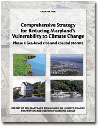Climate Adaptation: Building Societal, Economic, and Ecological Resilience
To adapt means to adjust to new or different conditions. In the case of adaptation to a changing climate, this means adjusting the way natural or human systems are managed in order to reduce potential loss or harm or to take advantage of future benefits. Both human and natural systems have been adapting to changing conditions for millennia. For example, wildlife migrate as habitat and food availability change; farmers diversify the crops they plant when droughts or floods become more common; and, engineers modify designs to withstand higher wind in hurricane prone areas.
How is Maryland planning to adapt?
Recog nizing that temperatures are already warming and sea level is rising; Maryland is taking steps to prepare for the inevitable impacts of climate change. These steps, often referred to as climate adaptation, are a set
of common sense solutions aimed at protecting resources and citizens from extreme events, rising sea level, and higher temperatures.
nizing that temperatures are already warming and sea level is rising; Maryland is taking steps to prepare for the inevitable impacts of climate change. These steps, often referred to as climate adaptation, are a set
of common sense solutions aimed at protecting resources and citizens from extreme events, rising sea level, and higher temperatures.
Maryland has developed two strategies that are currently being used to guide and prioritize state-level activities with respect to both climate science and adaptation policy.
The Phase I Adaptation Strategy for Sea Level Rise and Coastal Storms was released in August 2008. The Phase I Strategy is a key component of the
Maryland Climate Action Plan, detailing the actions necessary to protect Maryland's future economic well-being, environmental heritage and public safety in the face of climate change and sea level rise.
The Maryland Commission on Climate Change released its
Adaptation Phase II: Building Societal, Economic and Ecological Resilience in January 2011. Developed in accordance with Executive Order 01.01.2010.16, more than 80 experts collaborated and held stakeholder meetings to create the report. The Phase II Strategy lays out a suite of actions the State should take to address changes in precipitation patterns and increased temperature and the likely impacts to human health; agriculture; bay, aquatic, forest and terrestrial ecosystems; and built-infrastructure.